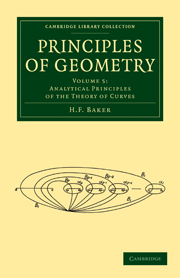Book contents
- Frontmatter
- PREFACE
- Contents
- CHAPTER I INTRODUCTORY ACCOUNT OF RATIONAL AND ELLIPTIC CURVES
- CHAPTER II THE ELIMINATION OF THE MULTIPLE POINTS OF A PLANE CURVE
- CHAPTER III THE BRANCHES OF AN ALGEBRAIC CURVE; THE ORDER OF A RATIONAL FUNCTION; ABEL'S THEOREM
- CHAPTER IV THE GENUS OF A CURVE. FUNDAMENTALS OF THE THEORY OF LINEAR SERIES
- CHAPTER V THE PERIODS OF ALGEBRAIC INTEGRALS. LOOPS IN A PLANE. RIEMANN SURFACES
- CHAPTER VI THE VARIOUS KINDS OF ALGEBRAIC INTEGRALS. RELATIONS AMONG PERIODS
- CHAPTER VII THE MODULAR EXPRESSION OF RATIONAL FUNCTIONS AND INTEGRALS
- CHAPTER VIII ENUMERATIVE PROPERTIES OF CURVES
- INDEX
CHAPTER VIII - ENUMERATIVE PROPERTIES OF CURVES
Published online by Cambridge University Press: 05 July 2011
- Frontmatter
- PREFACE
- Contents
- CHAPTER I INTRODUCTORY ACCOUNT OF RATIONAL AND ELLIPTIC CURVES
- CHAPTER II THE ELIMINATION OF THE MULTIPLE POINTS OF A PLANE CURVE
- CHAPTER III THE BRANCHES OF AN ALGEBRAIC CURVE; THE ORDER OF A RATIONAL FUNCTION; ABEL'S THEOREM
- CHAPTER IV THE GENUS OF A CURVE. FUNDAMENTALS OF THE THEORY OF LINEAR SERIES
- CHAPTER V THE PERIODS OF ALGEBRAIC INTEGRALS. LOOPS IN A PLANE. RIEMANN SURFACES
- CHAPTER VI THE VARIOUS KINDS OF ALGEBRAIC INTEGRALS. RELATIONS AMONG PERIODS
- CHAPTER VII THE MODULAR EXPRESSION OF RATIONAL FUNCTIONS AND INTEGRALS
- CHAPTER VIII ENUMERATIVE PROPERTIES OF CURVES
- INDEX
Summary
Part I. General formulae. In ordinary space of three dimensions, an algebraic surface is the locus represented by a single polynomial equation, F(x, y, z, t) = 0, homogeneous in the coordinates x, y, z, t. It is generally intended that the polynomial F is incapable of being written as the product of other polynomials, and the surface is then said to be irreducible. The order of the surface is the number of its intersections with an arbitrary line, and is the order of the polynomial F in x, y, z, t. Unless the contrary is stated we shall suppose the plane t = 0 to have no special relation with the surface, and shall often replace t by 1, and represent the equation by F(x, y, z) = 0.
An algebraic curve is most naturally regarded as the intersection of algebraic surfaces; two such surfaces meet in a curve. But it is not true conversely that any given algebraic curve is the complete intersection of two surfaces; a familiar example to the contrary is the rational cubic curve, which is the part intersection of two quadric surfaces having, beside, a line in common. Nor indeed is it clear that three algebraic surfaces can be drawn through a given curve so as to have this as their only common part; they may have, beside, points in common; in fact it will be seen below that a curve may be such that no three surfaces can be drawn through this which do not have also points in common not lying on this curve.
- Type
- Chapter
- Information
- Principles of Geometry , pp. 182 - 242Publisher: Cambridge University PressPrint publication year: 2010First published in: 1933

